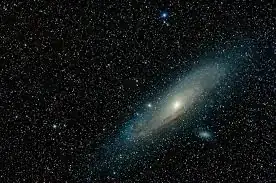Most such objects are too faint to see with the naked eye. There are about 9000 visible stars. They are nearby stars in our galaxy, which contains about a quarter trillion stars.
The nearest big galaxy is Andromeda. It is bright enough to see at least part of it. It appears as a fuzzy patch, not a point. It is 200,000 light years across and 2.5 million light years away. That means it is about 3 degrees across if you count all of it, not just the visible part. That is bigger than the sun, though much fainter.
On the scale of the galaxy, stars are tiny and separated by large distances. Our sun, bigger than a typical star, is 864,340 miles across. The nearest star is 4 light years away, or 23 trillion miles. If the nearest star was like the Sun. size/separation would be about $4 \cdot 10^{-6}$, a very tiny dot indeed.
Of course there are galaxies so far away they appear as points. But they are all too far away to see with just your eye.
This shows relative apparent sizes of various objects. https://xkcd.com/1276/
